Patented scaffolding is a hard-wearing steel scaffold structure featuring specialized couplings and frames. This component effortlessly adjusts the height of the scaffold, so there is no need to install additional sections manually. Patented scaffolding frames are highly durable and reliable structures ideal for various renovation and construction projects. Its adjustable work platform allows workers to experience safe and easy access to buildings at multiple heights.
The main benefits of patented scaffolding are speed, safety, ease of use, durability, and adjustability. It is also used extensively in building construction, repair and maintenance, painting, and decorating. The main parts of patented scaffolding are standards, ledgers, putlogs, and braces.
Table of Contents
What is Patented Scaffolding?
Patented scaffolding is a prefabricated, ready-to-use temporary structure made from steel or aluminum. This system has special coupling, frames, and platforms that boost safety and efficiency. All structure components of Patented scaffolding are pre-engineered, bringing precision and uniformity in design while making the erection process of patented scaffolding effortless. Patented scaffolding involves the setting up of working platforms on brackets for efficient workspace. Patented scaffolding has an intuitive design where laborers can quickly assemble the whole structure without requiring too many tools.
Furthermore, its modular design is economical both to produce and to erect, which helps reduce project costs. You can easily find patented scaffolding systems with adjustable heights and pre-fitted platforms, and you can adjust them per your specific project needs as and when required. Whether you need a temporary structure for complex industrial projects or residential construction, patented scaffolding is the best choice. When contractors seek efficiency and reliability in a construction project, this scaffold’s modern design and adaptability seem perfect. Patented scaffolds are readymade and have special couplings and frames attached to them, which simplifies assembly and ensures consistency across installations.
Patented Scaffolding Images


What are the Benefits of Patented Scaffolding?
The seven benefits of Patented Scaffolding are as follows:
- Speed
- Safety
- Easy of Use
- Durability
- Adjustability
- Reliability
- Efficiency
Speed: Speed is the biggest benefit of patented scaffolding as its overall structure is readymade, and workers can put it all together quickly. Its pre-assembled components make assembly quick and effortless. This reduces the overall cost because fewer workers are required to erect patented scaffolding. This speed of assembly helps you save time and cost while letting project managers easily meet project timelines.
Safety: Patent scaffolding is that it offers a safe platform for workers. The structure is durable and made of steel or aluminum, which offers high strength. It is featured with various safety features such as safe access points, a non-slippery platform, and safety guardrails. As a result, workers can complete their routine tasks at elevated heights with high safety and minimal risk of accidents and falls.
Ease of Use: Ease of use is another benefit of patented scaffolding. Its overall design is user-friendly. You get your hands on pre-assembled standard components with instruction manuals. Laborers can follow the instructions and assemble or dismantle the scaffold without any problem. It is an ideal type of scaffold for laborers with varied skills.
Durability: Patented scaffolding is highly durable. Two common materials used to manufacture its components are steel and aluminum. These high-material components are built to last for years. Patented scaffolding can withstand harsh weather and rough construction site conditions. This contributes to overall longevity and reliability. There is no need to seek frequent replacement of patented scaffolding, reducing the overall cost of the project.
Adjustability: Customization and adaptability are the top benefits of patented scaffolds. Specialized couplings and fittings allow you to adjust the structure’s shape, size, and height. Thus, it is a suitable temporary structure for various construction activities. When a project is complex and requires top-level customization, it’s easier to go with this structure.
Reliability: Patented scaffolding is a ready-made structure. Each component and part goes through a rigorous testing and quality control process. Heavy-strength material is used for the production of these components. As a result, contractors and workers invest in this scaffold as it offers structural integrity and reliability.
Efficiency: Another benefit of patent scaffolding is that it helps workers complete projects with utmost efficiency. This is possible due to quick assembly, user-friendly structure, and high level of customization. Workers can stand on a safe work platform and complete their tasks with productivity.
What are the Disadvantages of Patented Scaffolding?
The six disadvantages of patented scaffolding are as follows:
- High Initial Cost
- Limited Flexibility
- Requires Skilled Labor
- Maintenance Needs
- Transportation Challenges
- Weight
1. High Initial Cost
The biggest drawback of patented scaffolding is its high initial cost. It involves the purchase of custom components and specialized parts. The cost of these specialized parts is more than that of standard ones. You often customize parts as per your project requirements, so it’s when you will pay more. If you have a tight budget or small-scale project, you can’t incur this high initial cost.
2. Limited Flexibility
Most components of patented scaffolding are pre-designed and pre-assembled. You can’t modify them to meet specific project requirements. Their limited flexibility is the biggest drawback, as you can’t configure them for unusual construction site projects.
3. Requires Skilled Labor
Another disadvantage of patented scaffolding is that only skilled laborers can assemble and dismantle complete scaffold structures. If you don’t have skilled laborers, you must spend money training your workers first. Workers must be familiar with safety protocols, assembly, and proper use of this system. If a complex project has advanced modular components, then a high level of technical understanding is required, and only skilled labor can handle that.
4. Maintenance Needs
Another disadvantage of patented scaffolding systems is that they require regular inspection and maintenance. The repair cost of specialized components of patented scaffolding is higher than the repair cost for standardized components. The real problem arises when any of its unique components get damaged because that’s when you pay for the replacement parts. Inspectors will check every component for wear and tear or structural damage.
5. Transportation Challenges
The biggest problem with patented scaffolding is its transportation issues. Patent scaffolding consists of pre-assembled parts and components. They are quite heavy, and moving them around is a big issue. The modular components are large and require renting specialized vehicles, which increases transportation costs as well.
6. Weight
Since most components of patented scaffolding are modular or ready-made, their weight is usually high, as they are made of heavy materials like steel or aluminum. Another disadvantage of using patented scaffolding is that its handling is quite challenging. Workers need additional assistance to move these components on the construction site. They may need to use heavy machinery like forklifts or cranes during the assembly process.
What are the uses of Patented Scaffolding?
The seven uses of patented scaffolding are as follows:
- Building Construction
- Repair and Maintenance
- Painting and Decorating
- Window Cleaning
- Demolition Support
- Tight or Narrow Spaces
- High-Rise Buildings
1. Building Construction

Patented scaffolding is used in building construction. The pre-assembled parts and components of a modular system allow you to fit them as per your project requirements. They offer a stable and safe working platform with easy access points. Workers can use these platforms to access areas at elevated height levels.
2. Repair and Maintenance

Another everyday use of patented scaffolding is repairing and maintaining high-rise buildings and tall structures. It is easy to configure its components and access difficult-to-reach areas where traditional ladders and scaffolds can’t. Workers can use this structure in narrow building corners and uneven surfaces during repair and maintenance tasks with utmost safety.
3. Painting and Decorating

Patented scaffolding is also commonly used for painting and decorating high walls, facades, and ceilings. The best part of this scaffold is that it offers a stable working platform to painters and decorators who can stand safely on it and complete their tasks with utmost precision. You can adjust this scaffold to be aligned with window frames, decorative molding, and other intricate spaces. After this adjustment, you can complete a more detailed and accurate task.
4. Window Cleaning

Patented scaffolding proves helpful when cleaning windows at high altitudes. It is a safe alternative to traditional lifts and ladders. No matter how tight the spaces are or how narrow the alleyways are, this specific scaffold structure can access the area and clean windows. It has guardrails and secure harness points so workers can safely perform window cleaning tasks in hard-to-reach places.
5. Demolition Support

Patented scaffolding is used as a demolition support. It provides structural support while workers are completing the demolition work. This heavy-steel structure has a high load-bearing capacity. It can support heavy loads and withstand the excessive forces exerted by the structure during the demolition process. At the same time, patented scaffolding protects workers against debris and other objects and offers them a safe environment from elevated positions. This system is helpful for both partial and complete building demolition projects.
6. Tight or Narrow Spaces

Patented scaffolding greatly supports workers while working in limited spaces such as alleys, narrow streets, etc. This scaffold structure has pre-assembled components that help you create a compact and flexible design. So, if you plan to work in tight spaces in urban areas, this temporary structure is the best choice. Workers get easy access to work areas in tight spaces.
7. High-Rise Buildings

Patented scaffolding is used for high-rise building projects. It has a safety mechanism that allows users to work safely at elevated heights. Besides, it offers adjustments that other scaffolding doesn’t. You can adjust the scaffold per project requirements when you need to work at varied height levels. The biggest challenge of working on high-rise buildings is windy conditions that often cause swaying and collapse of structures, and patented scaffolds allow users to overcome these challenges. Its strong and durable structure withstands heavy wind and adverse weather conditions. As a result, your workers can work on projects safely in heavy wind scenarios, and you can reduce the risk of accidents.
What are the parts of Patented Scaffolding?
The seven parts of patented scaffolding are as follows:
- Standards
- Ledgers
- Braces
- Putlogs
- Planks/Boarding
- Rails/Guard Boards
- Volts
1. Standards

Standards are vertical posts and columns that act as the backbone of patented scaffolds. They are primary support poles that bear the load of the entire system. Standards are made from steel or aluminum and are spaced at regular intervals throughout the structure. The patented system’s standards are modular, so it’s quite easy for workers to connect them to other parts of the system. These vertical scaffolds are a must for ensuring structural stability and height.
2. Ledgers
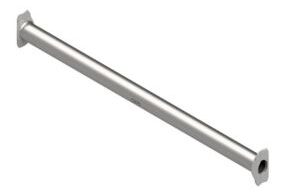
Ledgers are horizontal beams connected to the standards. They serve as the supporting area for the working platforms. Ledgers are installed at varied heights and help distribute the weight of tools, workers, and materials throughout the structures. They provide lateral stability to the patented scaffold structure while holding the working level of the scaffold up.
3. Braces
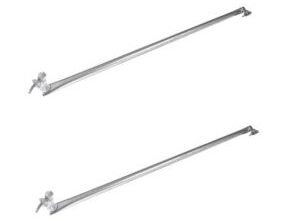
Braces are diagonal supports of the patented scaffold. They are an essential component of the structure as they stabilize it and prevent it from buckling or swaying. Diagonal braces are installed in a diagonal position between the vertical and horizontal components of the framework. They can prevent lateral movement of scaffolds.
4. Putlogs
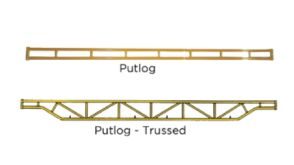
Putlogs are horizontal beams placed on the edge of the structure. They provide support to the scaffold’s platform and act as a connection point between the building and the scaffold. They are essential parts of a patented scaffold, as the whole framework is supported by the building after secure attachment.
5. Planks/Boarding
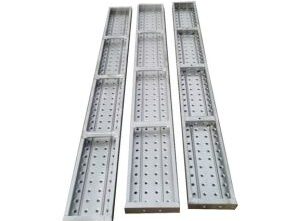
Planks are the wooden and metal boards that serve as the main surface for workers to walk, stand, and place tools. This part of patented scaffolding provides a solid platform for workers.
6. Rails/Guard Boards
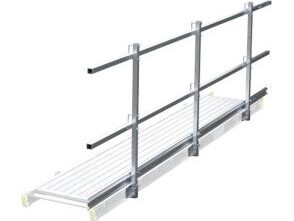
Rails and guard boards are safety features installed on the patented scaffolding. They are a crucial part of the fall protection system for the workers. The system consists of a top rail, a mid rail, and toeboards installed alongside the perimeter of the scaffold. They prevent accidental falls and keep people and property below safe.
7. Volts

Volts are vertical ties that connect the scaffold to the supporting structure around it. Once ties are placed, they prevent swaying due to shifting loads and winds. In the patented scaffolding, volts are like anchors that keep the structure firmly secured to the building. Volts are installed at regular intervals around the framework’s vertical parts, ensuring overall structural stability.






